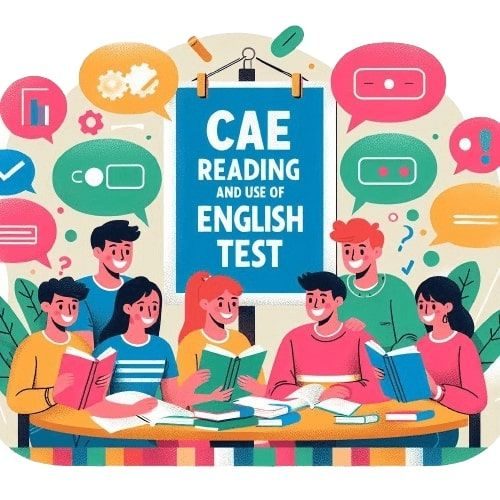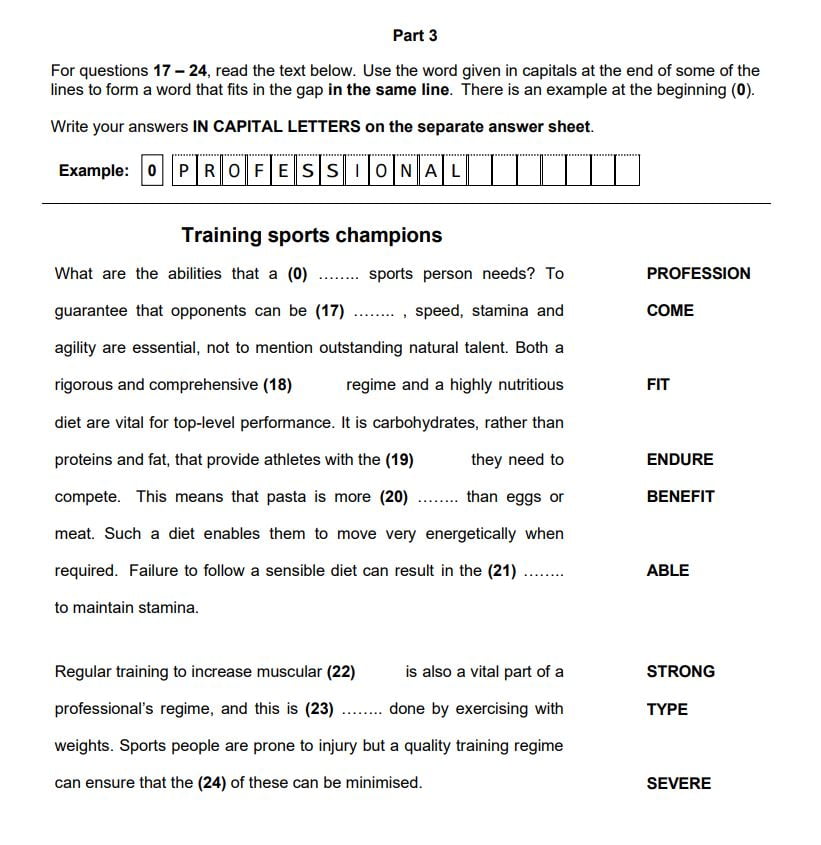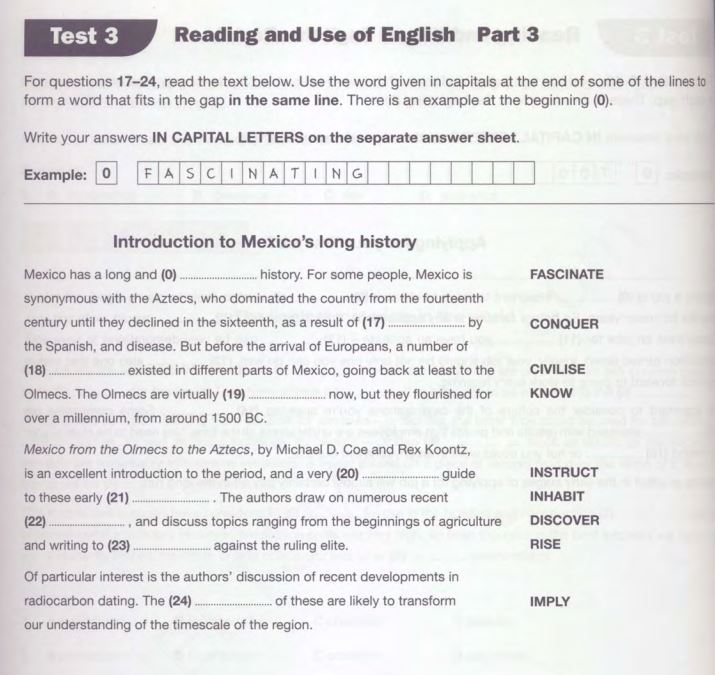Cambridge C1 (CAE): Reading and Use of English Part 3

Key Points
- Reading and Use of English (RUE): The RUE paper consists of 8 parts, taking 90 minutes, focusing on English grammar, vocabulary, and reading comprehension.
- Part 3 – Word Formation: This part tests lexical knowledge and the ability to form words from given stems, requiring an understanding of prefixes, suffixes, and word structure.
Answering Strategy: Candidates should understand the sentence’s meaning, identify the correct part of speech needed, and ensure the new word fits grammatically and contextually.
What you will find in this guide:
C1 (CAE) Reading and Use of English Part 3
The CAE Reading and Use of English Part 3, also known as ‘Word Formation’, is one of the eight parts of the Reading and Use of English paper, but it is among the easiest ones! As the Cambridge themselves put it, Part 3, consists of a text containing eight gaps. To the right of the screen in the digital exam, or at the end of some of the lines, and separated from the text in the paper-based exam, there is a stem word in capital letters. As a candidate, you need to form an appropriate word from given stem words to fill each gap.
The focus of this task is primarily lexical, though an understanding of structure is also required.
The focus of this task is primarily on vocabulary, though an understanding of structure is also required. It tests your knowledge of how prefixes, suffixes, internal changes and compounds are used in forming words. In Cambridge C1 (CAE) reading and use of English part 3, you are required to demonstrate your understanding of the text beyond sentence level.
For example, if the stem word is “manage,” you might need to transform it into “management,” “managerial,” or “unmanageable,” depending on the context provided by the text. This requires a solid understanding of word families and parts of speech, which are crucial in determining the correct form of the word.
In this guide, I’ll walk you through each aspect of Part 3, from dissecting the structure to sharing tips that have helped countless students succeed. Whether you’re self-studying or seeking guidance as a teacher, this guide aims to equip you with everything you need to approach Part 3 with confidence.
Part 3 Structure
Part 3 gives you a text that could be about any topic, from science to humanities. The text is filled with gaps that test your ability to deduce and manipulate language. Each gap requires you to sift through four choices and select the one that best completes the sentence, not just grammatically but also contextually. Here’s a detailed guide to how CAE reading and use of English part 3 is structured:
1. Text Type: The text presented in Part 3 is usually a short extract from a newspaper, magazine, or promotional material.
2. Task Type: You will be given a text containing eight gaps (plus one example at the beginning). Each gap represents a missing word, and you must use the base word provided next to each gap to form the correct word that fits in the context of the text.
3. Word Types: The words you need to form can be different parts of speech, including nouns, verbs, adjectives, or adverbs. You may need to add prefixes or suffixes, or make internal changes to the base word.
4. Number of Questions: There are eight questions in this part, each worth one mark.
5. Skills Tested: This part tests your knowledge of word formation and your ability to understand how words can be changed to fit into different contexts within a text.
6. Scoring: Each correct answer is awarded one mark. There is no penalty for incorrect answers, so it’s worth attempting every question.
Sample Question

Potential challenges
As an experienced English teacher and proficiency exam coach, I’ve seen firsthand how grammar and vocabulary tasks can be stumbling blocks for even the most diligent students. The Cambridge C1 Advanced (CAE) Reading and Use of English Part 3 is no exception, presenting a unique set of challenges that test the depth and flexibility of your language skills. In this part, I will share my experience of working with numerous students to let you know what potential challenges you may face in your exam preparation endeavor. Knowing these challenges can help you prepare better and make sure you will have a plan to overcome them. Here’s a detailed guide on the challenges of CAE reading part 3 to help you manage these challenges:
1. Expansive Vocabulary
- To excel in Part 3, you must have an extensive vocabulary. Regular reading and exposure to diverse English texts can build this up over time.
2. Mastery of Parts of Speech
- Understanding parts of speech is crucial. Words can change their function in a sentence, like “beauty” becoming “beautiful” or “beautifully.”
3. Prefixes and Suffixes
- A firm grasp of prefixes and suffixes is essential as they modify meanings. For example, “un-” can turn “happy” into “unhappy.”
4. Contextual Application
- The correct word must fit the context both grammatically and semantically.
Guide to Part 3
Part , the word formation, tests your familiarity with the principles of word formation (use of prefixes, suffixes, internal changes, compounding). Unlike parts 1 and 2, you have the correct word stem, but need to formulate the right form of the stem word that matches the sentence. So, please consider the following:
Step 1:
Read the sentence and the stem word that you have, and try to comprehend the general meaning of the sentence containing the blank space. This is vital because you need to complete the idea expressed in that sentence.
Step 2:
Put the stem word (the word given in the test) in the blank and Read the sentence again with the word you put in the blank space. This will give you an idea of what needs to be said in that sentence.
Step 3:
Read the word before the gap and the word after the gap to see which part of speech of the stem word (the word given to you) should be used in the blank. (adjective, noun, adverb, verb).Then, transform the word into the part of speech you identified and write it in the blank in CAPITAL LETTERS.
Step 4:
Make sure that the word matches the idea expressed in that sentence, and that it is grammatically correct when used. This is where you need to make sure your word collocates with the word after the blank, or that it is the right part of speech for that part of the sentence. This is essential because you need to write a word that correctly matches the grammar of the sentence it is placed in.
Step 5:
Read the next sentence and double check your answer to see if it matches the broader meaning expressed in that part of the text.
Step 6:
Make sure your answer is spelled correctly
Step 7:
Make sure to write only one word.
Part 3 Practice Test
Use the guide to practice reading and use of English part 3 using the following sample test.

References
Cambridge C1 Advanced (CAE): Reading and Use of English Part 3.
C1 Advanced Handbook for teachers for exams.” Cambridge English.
Cambridge C1 Advanced (CAE): Reading and Use of English Part 3.
C1 Advanced Handbook for teachers for exams – Cambridge English.
Cambridge English Advanced: Reading and Use of English Part 3.
A DETAILED GUIDE TO CAE – englishservice.cz.
C1 Advanced (CAE) Use of English – The Complete Guide. C1 Advanced preparation | Cambridge English.
How was your experience?
Describe your experience taking Reading and Use of English part 3 in the comment section below.







I think this part is not difficult if you know a lot of vocabulary, but if you don’t know some words it will be difficult, but I think is easier than the bother partes because we have already the word and we just have to identify if we need a verb, noun, etc.
This part could be the easiest if you have a expand vocabulary and if you can apply suffixes and prefixes to the words there are in the reading.
This part is easier because you have the options there, so you need to change according to the sentence . However, I can say that is a little bit difficukt because sometimes I don´t know the correct word so I lost points.
Part 3 is much easier than the previous ones because we have the base of the form that we need to transform. It is just necessary that we think correctly about the word form and how words work.
Ir might be the easiest part but I still get confused. However the tips help somehow